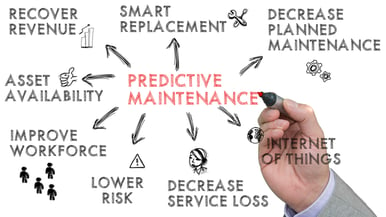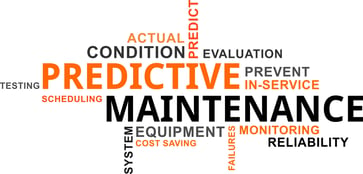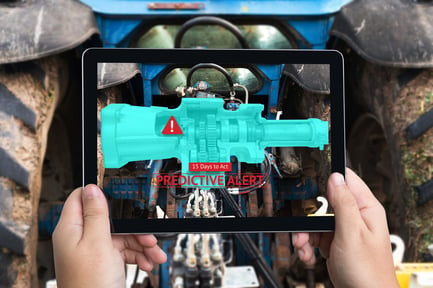 Machine breakdowns are normal occurrences in the manufacturing industry. The repetitive functions of each machine inevitably lead to failures and downtime. The trouble with this, of course, is that manufacturing today requires greater levels of efficiency and quality output. Any equipment failures resulting in unplanned downtime can lead to service delays, disgruntled customers, and possible losses in terms of productivity and income.
Machine breakdowns are normal occurrences in the manufacturing industry. The repetitive functions of each machine inevitably lead to failures and downtime. The trouble with this, of course, is that manufacturing today requires greater levels of efficiency and quality output. Any equipment failures resulting in unplanned downtime can lead to service delays, disgruntled customers, and possible losses in terms of productivity and income.
However, technological innovation, such as the development of industrial IoT (Internet of Things) has made it possible to utilise machine data to improve operational performance and process efficiency. The availability of IoT has made it possible to optimise the remote monitoring and maintenance capabilities it offers to minimise the costs and consequences of both planned and unplanned downtime. This is a process commonly referred to as predictive maintenance. But even with these benefits, some manufacturers have yet to adopt it.
Predictive maintenance vs. reactive maintenance
 First off, we need to distinguish predictive maintenance from reactive maintenance (which more people are familiar with). The former is a process whereby the maintenance requirements of machinery in a production facility or factory are anticipated. Reactive maintenance, as most of us already know, is when machines are serviced or repaired only when they actually fail or break down.
First off, we need to distinguish predictive maintenance from reactive maintenance (which more people are familiar with). The former is a process whereby the maintenance requirements of machinery in a production facility or factory are anticipated. Reactive maintenance, as most of us already know, is when machines are serviced or repaired only when they actually fail or break down.
Based on this differentiation, it would be easy to understand that reactive maintenance leads to substantial costs in terms of the kind of repair work required or even the possible need for replacement. In some cases, due to one part failing but not being attended to or addressed, other parts get damaged as well when this could have been easily avoided. Moreover, unexpected breakdowns significantly impact production output and quality, and any delays in production negatively affect the bottom line.
As opposed to reactive maintenance, predictive maintenance utilises data collected from each machine based on its normal pattern of operation or performance. Any minute changes or inconsistencies with the baseline data detected by sensors will lead to subsequent alerts so that operators can reasonably predict the necessity for maintenance work. This way, any damage or fault remains isolated, so other parts remain unaffected, and total equipment failure is avoided.
Benefits of predictive maintenance
When it comes to preserving the lifespan of machines, predictive maintenance is the clear winner. Moreover, it offers manufacturing entities the following additional advantages:
- Reduction of unexpected failures and downtime. Since by its very nature, predictive maintenance is anticipatory, it effectively reduces and may even eliminate the incidence of unexpected equipment failure. This, in turn, can significantly reduce the incidence of downtimes or service interruptions.
- Reduction of maintenance expenses. Predictive maintenance helps manufacturers avoid costly repairs and or replacement of parts or machines because the fault is detected, isolated, and fixed before severe machine damage occurs. Moreover, since preventive maintenance is intended to preempt significant damage to equipment, there will be no need for extensive repair work as well as emergency servicing.
- Reduction of repair and overhaul time. Machine faults are diagnosed before they get worse, so repair work is kept to a minimum, thereby eliminating the need for major overhauls which can take several hours or even days.
- Ensuring worker safety. Undetected faults in machinery increase the risk of accidental injury or even death occurring during operations. Predictive maintenance prevents this by detecting problems while they are still small and can be easily repaired or addressed.
- Improvement in production output. Reduced machinery downtime means more efficient production planning. Manufacturing processes stay on schedule, which, in turn, positively affects the bottom line, especially for the long term.

A report by McKinsey published in 2015 explored the many uses of industrial analytics, including predictive maintenance, and uncovered significant advantages.
Firstly, predictive maintenance can reduce maintenance costs by 10 to 40 per cent as it eliminates the need for unnecessary planned maintenance work.
Secondly, predictive maintenance can reduce waste by 10 to 20 per cent since it basically uncovers faults before they become issues leading to wasted time, resources and energy.
Lastly, it was found that predictive maintenance can increase new improvement opportunities by 10 to 50 per cent as data collection and advanced analytics can be used to identify system gaps or inefficiencies. This way, they can be addressed, modified and resolved.
How to prepare your company for predictive maintenance
If you are gearing up to adopt predictive maintenance in your company, be sure to take care of the following:
- Get to the root of the problem you have identified and want to fix, and then identify the people in your company who will be involved in the project from planning to implementation. Are you concerned about specific machines breaking down, or do you want to focus on preventing unplanned downtimes? Be specific about your goals as you will need to communicate these to the people who will be involved in the preventive maintenance project. They need to be as invested as you are in the importance of adopting preventive maintenance.
- Check your current status, or come up with baseline data on machine performance. This entails a complete asset or facility equipment inventory. Keep records on vital information about each machine, including its name, make and model, serial number, etc. Be sure to evaluate each machine as well as its performance history and maintenance records.
- Analyse the data for breakdown or failure patterns, and come up with measures to be used as problem indicators, and preventive maintenance procedures. Again, be detailed in showing what steps need to be taken regarding different scenarios as well as the tools and resources to be used in each step.
- Devise a preventive maintenance schedule and make a list of high-priority items (your most valuable assets). Based on your list, set a schedule for preventive maintenance for each one, starting from high priority assets to lower priority items. Also, make room for the possibility of emergency maintenance incidents still coming up while your preventive maintenance project is still in its nascent stages.
- Adopt a computerised maintenance management system (CMMS) if you have not yet done so, and ensure you have staff trained to handle preventive maintenance work. Again, it is essential that the staff involved in the project understand its value and long-term impact on the company so they become invested. Moreover, you need to also invest in their training as a well-utilised CMMS can significantly improve ROI.
The work does not stop there, however. You also need to put in place a process for updating data continuously, and ensure data collected is accurate or precise.
Keep analysing and refining your system, and be ready to adopt new technology that will enhance operations and improve efficiency. Soon, as AI becomes mainstream, and the benefits of machine learning are better understood, more manufacturing companies may be willing to invest in predictive maintenance and allied technology.
Martin Thomas, European Marketing Manager at Radwell International Ltd explains more. “In the meantime, it should be emphasised that companies that have already adopted predictive maintenance are poised to become industry leaders. The current demands on manufacturing already require its adoption. And although preventive maintenance may still seem to be a choice or one of the alternatives when it comes to asset maintenance for industries, that is no longer the case. The future belongs to visionary companies that have already embraced it.”









